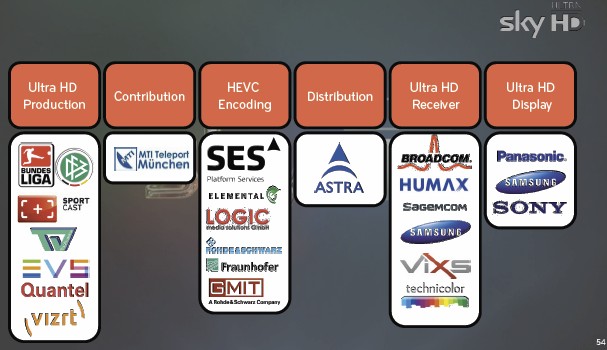Stephan Heimbacher of Sky Deutschland spoke at a seminar by SES about the live delivery of UltraHD TV tests that were conducted. Sky has been looking at UltraHD for some years and is working towards delivering UltraHD. This started with recording content for testing. However, Sky wanted to understand the issues of live UltraHD and decided to broadcast two soccer matches in the format.
After a couple of weeks work, on 26th April, Sky transmitted a soccer match 2160P50. Live use was always important because sport is a great driver of Sky’s business and has enabled technology developments.
In the 26th April test, there were 6 UHD cameras and 4 HD cameras with HD for up conversion to UltraHD (normally a football match would use as many as 15 or 16 cameras). Up converting was done in the OB van where the graphics were added in UltraHD. There were four 3G-SDI streams needed to deliver the content. Going from interlaced to progressive combined with higher resolution, plus supporting 10 bit colour means that a typical 0.83GBit for HD goes up to 8.3 GBit for UltraHD!
Encoding was done by Elemental and by technology from the Fraunhofer HHI. The tests had to wait until after NAB this year to get access to real time encoders. The first half was compressed by Elemental and the second half by Fraunhofer. Each codec had its own artefacts, and Heimbacher said that neither was better. Many of the artefacts were fixed by the time of the May test. He said that the engineers were able to quite quickly work out which parts of the codec were causing issues.
The uplink was via SES and consumption on some TV sets was at Sky in Munich. Compression was set at 276:1 to fit into the satellite transponder.
For the second match, to see if the bit stream could be reduced, the first half was uncompressed from the OB van (at 8.3GBits), but the second half used JPEG 2000 to reduce the bit stream to the contribution centre down to around 1.0Gbps. There were some problems using JPEG 2000 with quadrants getting out of sync as the signal was being treated as though it was four FullHD streams. Heimbacher said that the compression was probably too high in the JPEG domain as it was visible in the final quality.
Going step by step, at capture, there was a dedicated OB van and a dedicated commentator, even though only a few listeners. Viz RT did the graphics and the graphics were found to be very clearly different when created in 4K than in FullHD and upscaled. For the first match, traditional camera positions were used, but the centre camera was further away and higher up so that you could capture “almost the whole pitch”. There was some panning, but only slowly. By the second match, new positions were used that were more immersive.
In Berlin, there was some testing of different bit rates from 15Mbps to 25 and up to 35. At the moment, 30Mbps seems to be needed today, but there is an expectation that bit rates will come down as encoders mature. (SES has said that it believes that the budget from broadcasters is around 25Mbit).
Heimbacher said that SES and Sky may organise a UHD “plugfest” to check receivers and see the differences.
There were experts and non-experts in the tests. Experts thought that the wide view didn’t work at 65″. They also found that the fixed prime lens can be “dull” and thought that HD upscaling was visible. However, the “behind the goal”, low down camera position is a good view.
Turning to the consumer view, there was a quality step up visible (for sports), but not it’s not so obvious and there is no major “wow” effect.
Football fans like the wide view as they can see the tactics being used by each team more clearly. Motion blur was partially noticeable at 50fps and the viewing angle switch confused some viewers due to high realism. They became so immersed that when the view changed, it made them feel as though they had physically moved!
Heimbacher said that you really need HDR and maybe frame rate for real “Wow”
Display Daily Comments
In questions, someone that had been at some BT tests of world cup soccer in UltraHD said that the audience had thought there was a real “Wow” factor.


